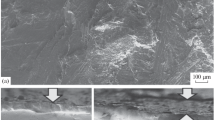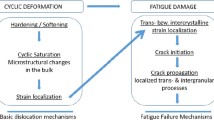Abstract
Thin foils of an aluminium alloy containing the fracture surface were studied in the electron microscope. The fatigue striations were visible due to thickness contrast and bands of dislocations. Supplementary etch pit studies and stereographic measurements were carried out.
In many cases the crack plane was close to (100) or (110). The mechanism of fatigue crack propagation is discussed in the light of the new evidence.
Résumé
La surface de rupture d'un alliage d'aluminium a été étudiée par pellicules minces en utilisant la microscopie électronique par transmission. On a observé les stries de fatigue, qui ont également fait l'objet de mesures fractographiques. On remarque que le plan de la fissure est souvent proche de (110) ou de (100). On discute le mécanisme de la propagation des fissures de fatigue sur la base de ces résultats.
Zusammenfassung
Dünne Folien aus einer Aluminiumlegierung welche die Bruchflächen enthielten, wurden mit Hilfe der Durchstrählungselektronenmikroskopie untersucht. Dank des Dickenunterschiedes und der Versetzungslinien waren die Ermüdungslinien sichtbar. Zusätzliche Ätzgruben- und stereographische Prüfungen wurden durchgeführt.
In vielen Fällen war die Bruchfläche annähernd entlang den Richtungen (110) oder (100). Der Mechanismus der Fortpflanzung eines Ermüdungsbruchs wird im Lichte dieser neuen Erkenntnisse erörtert.
Similar content being viewed by others
References
J. C. Grosskreutz and G. G. Shaw, Microstructure at the tips of growing fatigue cracks in aluminium alloys, ASTM STP 415 (1966) 226–243.
M. Klesnil and O. Lukas, Dislocation substructure associated with a propagating fatigue crack, IInd Int. Conf on Fracture. Brighton 1969. Paper 63. Chapman and Hall (1969) 725–730.
C. Q. Bowles and D. Broek, The microstructure of fatigue fracture surfaces, Reports of current Research, Int. J. of Fracture Mech., 4 (1969) 4.
P. J. E. Forsyth, Fatigue damage and crack growth in aluminium alloys, Acta Met., 11 (1963) 703–715.
R. M. N. Pelloux, Mechanisms of formation of ductile striations, ASM Trans. Quarterly, 62 (1969) 1.
D. Broek, A critical note on electron fractography, Eng. Fract. Mech., 1 (1970) 691–695.
C. A. Stubbington, Some observations on air and corrosion fatigue of an aluminium-7.5% Zinc-25% Magnesium alloy. Metallurgia, 68 (1963) 109–121.
C. Laird, The influence of metallurgical structure on the mechanism of fatigue crack propagation, ASTM STP 415 (1966) 131–180.
R. W. Hertzberg, Fatigue fracture surface appearance, ASTM STP 415 (1966) 205–225.
R. M. N. Pelloux, Corrosion fatigue crack propagation, IInd Int. Conf. on Fracture, 1969, paper 64, Chapman and Hall (1969) 731–744.
J. Schijve, Significance offatigue cracks in micro-range and macro-range, ASTM STP 415 (1967) 415–459.
J. C. McMillan and R. M. N. Pelloux, Fatigue crack propagation under program and random loads, ASTM STP 415 (1966) 505–532.
J. Schijve, Analysis of the fatigue phenomenon in aluminium alloys, NLR Report TR M.2122.
D. Broek and W. J. Van der Vet, Systematic electron fractography of fatigue in aluminium alloys, NLR Report TR 68002, Nov. 1967.
J. C. Grosskreutz and P. Waldon, Substructure and fatigue fracture in aluminium, Acta Met., 11 (1963) 717–724.
C. E. Feltner, Dislocation arrangements in aluminium deformed by repeated tensile stresses, Acta Met., 11 (1963) 817–828.
M. Gel] and G. R. Leverant, The effect of temperature on fatigue fracture in a directionally-solidified nickel-base superalloy, IInd Int. Conf. on Fracture (1969) paper 49, Chapman and Hall (1969) 565–575.
C. M. Wan and J. G. Byrne, The influence of stacking fault energy on fatigue fracture. IInd Int. Conf. on Fracture (1969) paper 52, Chapman and Hall, (1969) 598–606.
D. Kuhlmann-Wilsdorf and W. D. Nine, Striations on copper single crystals subjected to torsional fatigue. II. On the mechanism of fatigue striation formation and fatigue failure at low strain amplitudes, J. of App. Phys., 38 (1967) 1683–1693.
Author information
Authors and Affiliations
Additional information
The work has been carried out at the National Aerospace Laboratory NLR, Amsterdam.
Rights and permissions
About this article
Cite this article
Bowles, C.Q., Broek, D. On the formation of fatigue striations. Int J Fract 8, 75–85 (1972). https://doi.org/10.1007/BF00185199
Received:
Revised:
Issue Date:
DOI: https://doi.org/10.1007/BF00185199




